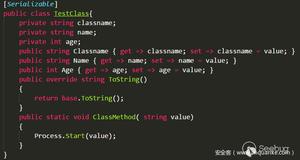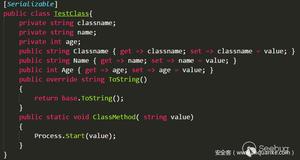asp.net core2.2多用户验证与授权示例详解
前言
asp.net core2.2 用户验证 和授权有很详细和特贴心的介绍,我感兴趣的主要是这两篇:
- cookie身份验证
- 基于角色的授权
我的项目有两类用户:
- 微信公众号用户,用户名为公众号的openid
- 企业微信的用户,用户名为企业微信的userid
每类用户中部分人员具有“Admin”角色
因为企业微信的用户有可能同时是微信公众号用户,即一个人两个名,所以需要多用户验证和授权。咱用代码说话最简洁,如下所示:
public class DemoController : Controller
{
/// <summary>
/// 企业微信用户使用的模块
/// </summary>
/// <returns></returns>
public IActionResult Work()
{
return Content(User.Identity.Name +User.IsInRole("Admin"));
}
/// <summary>
/// 企业微信管理员使用的模块
/// </summary>
/// <returns></returns>
public IActionResult WorkAdmin()
{
return Content(User.Identity.Name + User.IsInRole("Admin"));
}
/// <summary>
/// 微信公众号用户使用的模块
/// </summary>
/// <returns></returns>
public IActionResult Mp()
{
return Content(User.Identity.Name + User.IsInRole("Admin"));
}
/// <summary>
/// 微信公众号管理员使用的模块
/// </summary>
/// <returns></returns>
public IActionResult MpAdmin()
{
return Content(User.Identity.Name + User.IsInRole("Admin"));
}
}
下面咱一步一步实现。
第一步 改造类Startup
修改ConfigureServices方法,加入以下代码
services.AddAuthentication
(
"Work" //就是设置一个缺省的cookie验证的名字,缺省的意思就是需要写的时候可以不写。另外很多时候用CookieAuthenticationDefaults.AuthenticationScheme,这玩意就是字符串常量“Cookies”,
)
.AddCookie
(
"Work", //cookie验证的名字,“Work”可以省略,因为是缺省名
option =>
{
option.LoginPath = new PathString("/Demo/WorkLogin"); //设置验证的路径
option.AccessDeniedPath= new PathString("/Demo/WorkDenied");//设置无授权访问跳转的路径
}).AddCookie("Mp", option =>
{
option.LoginPath = new PathString("/Demo/MpLogin");
option.AccessDeniedPath = new PathString("/Demo/MpDenied");
});
修改Configure方法,加入以下代码
app.UseAuthentication();
第二步 添加验证
public async Task WorkLogin(string returnUrl)
{
var claims = new List<Claim>
{
new Claim(ClaimTypes.Name, "UserId"),
new Claim(ClaimTypes.Role, "Admin") //如果是管理员
};
var claimsIdentity = new ClaimsIdentity(claims, "Work");//“,"Work"”可以省略,因为是缺省名
var authProperties = new AuthenticationProperties
{
AllowRefresh = true,
//ExpiresUtc = DateTimeOffset.UtcNow.AddMinutes(10),
// The time at which the authentication ticket expires. A
// value set here overrides the ExpireTimeSpan option of
// CookieAuthenticationOptions set with AddCookie.
IsPersistent = false, //持久化保存,到底什么意思我也不太清楚,哪位兄弟清楚的话,盼解释
//IssuedUtc = <DateTimeOffset>,
// The time at which the authentication ticket was issued.
RedirectUri = returnUrl ?? "/Demo/Work"
};
await HttpContext.SignInAsync("Work", new ClaimsPrincipal(claimsIdentity), authProperties);
}
public IActionResult WorkDenied()
{
return Forbid();
}
public async Task MpLogin(string returnUrl)
{
var claims = new List<Claim>
{
new Claim(ClaimTypes.Name, "OpenId"),
new Claim(ClaimTypes.Role, "Admin") //如果是管理员
};
var claimsIdentity = new ClaimsIdentity(claims, "Mp");//“,"Mp"”不能省略,因为不是缺省名
var authProperties = new AuthenticationProperties
{
AllowRefresh = true,
IsPersistent = false,
RedirectUri = returnUrl ?? "/Demo/Mp"
};
await HttpContext.SignInAsync("Mp", new ClaimsPrincipal(claimsIdentity), authProperties);
}
public IActionResult MpDenied()
{
return Forbid();
}
第三步 添加授权
就是在对应的Action前面加[Authorize]
/// <summary>
/// 企业微信用户使用的模块
/// </summary>
/// <returns></returns>
[Authorize(
AuthenticationSchemes ="Work" //缺省名可以省略
)]
public IActionResult Work()
{
return Content(User.Identity.Name + User.IsInRole("Admin"));
}
/// <summary>
/// 企业微信管理员使用的模块
/// </summary>
/// <returns></returns>
[Authorize(AuthenticationSchemes ="Work",Roles ="Admin")]
public IActionResult WorkAdmin()
{
return Content(User.Identity.Name + User.IsInRole("Admin"));
}
/// <summary>
/// 微信公众号用户使用的模块
/// </summary>
/// <returns></returns>
[Authorize(AuthenticationSchemes ="Mp")]
public IActionResult Mp()
{
return Content(User.Identity.Name + User.IsInRole("Admin"));
}
/// <summary>
/// 微信公众号管理员使用的模块
/// </summary>
/// <returns></returns>
[Authorize(AuthenticationSchemes ="Mp",Roles ="Admin")]
public IActionResult MpAdmin()
{
return Content(User.Identity.Name + User.IsInRole("Admin"));
}
Ctrl+F5运行,截屏如下:
最后,讲讲碰到的坑和求助
坑
一开始的验证的代码如下:
public async Task<IActionResult> Login(string returnUrl)
{
var claims = new List<Claim>
{
new Claim(ClaimTypes.Name, "UserId"),
new Claim(ClaimTypes.Role, "Admin") //如果是管理员
};
var claimsIdentity = new ClaimsIdentity(claims, "Work");//“,"Work"”可以省略,因为是缺省名
var authProperties = new AuthenticationProperties
{
//AllowRefresh = true,
//IsPersistent = false,
//RedirectUri
};
await HttpContext.SignInAsync("Work", new ClaimsPrincipal(claimsIdentity), authProperties);
return Content("OK");
}
- 返回类型为Task<IActionResult> ,因为懒得写View,顺手写了句return Content("OK");
- 从网站复制过来代码,AuthenticationProperties没有设置任何内容
运行起来以后不停的调用login,百度了半天,改了各种代码,最后把return Content("OK");改成return RedirectToAction("Index");一切OK!
揣摩原因可能是当 return Content("OK");时,自动调用AuthenticationProperties的RedirectUri,而RedirectUri为空时,自动调用自己。也不知道对不对。
这时候重视起RedirectUri,本来就要返回到returnUrl,是不是给RedirectUri赋值returnUrl就能自动跳转?
确实,return Content("OK");时候自动跳转了,return RedirectToAction("Index");无效。
最后把Task<IActionResult> 改成Task ,把return ...删除,一切完美!(弱弱问一句,是不是原来就应该这样写?我一直在走弯路?)
求助
User有属性Identities,看起来可以有多个Identity,如何有?
总结
以上是 asp.net core2.2多用户验证与授权示例详解 的全部内容, 来源链接: utcz.com/z/354652.html





